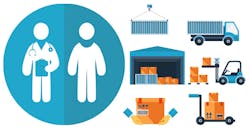Outpatient supply logistics stresses healthcare without walls
In an ideal continuum of care complete with personalized medicine that powers community healthcare performance, the curtains separating the clinical organizations and classes of trade would be transparent, if not non-existent.
In this model, care would be convenient, fueled by process standardization, seamless delivery, secure but open access to information by appropriate parties (clinician and patient) and a fluid demand-driven supply chain with no stockouts or delayed deliveries — from manufacturer through distributor through provider and … wait for it … to the patient’s home.
Within each patient’s care channel or care network, clinicians and administrators — including supply chain — would have convenient access to products and services via an interoperable IT structure that included a universal item master and charge data master linked to electronic health records and the payer community. Data would be accurate with no need for cleansing or scrubbing.
Arguably, we’re not there yet.
Whether such trendy concepts as artificial intelligence, blockchain, the Internet of Things or machine-to-machine learning and communication will push the industry in that direction, and how quickly, remains to be seen. Clearly, interoperable connectivity, virtually seamless communication and process flow, and progressively minded leadership represent the hallmarks of healthcare excellence. Of course, a patient (emotional) community must bide its time until that develops to fruition.
Until then, we scan for sparks in the field and leaders in the market, demonstrating not so much how it’s done, but at least displaying how they’re migrating where they need to be.
Horizon scanning
Outside of the acute-care hospital in the vastness known as non-acute or post-acute care, methods and models abound on how to supply those ambulatory surgery centers, urgent care facilities, physician practices, imaging centers, long-term care facilities, retail healthcare outlets and extending even to the patient’s home.
Within hospitals, the prevailing model of choice hovers around centralization (in terms of operational decisions, oversight and control) and standardization (in terms of products and processes). This applies to a simple healthcare system where a single hospital may also own and operate multiple non-acute care facilities or to an integrated delivery network where multiple hospitals and healthcare systems band together to provide services in a larger geographic area.
When it comes to non-acute care facilities catering to outpatients, however, the methods of service tend to vary beyond the monolithic. Most everyone knows that the demographics of non-acute care facilities tend to be different from acute-care hospitals; namely, there’s way many more of them scattered throughout wide swaths of land and they tend to order in way smaller quantities more frequently requiring more touches, which can prove costly from a logistical standpoint.
Aside from the ever-lingering “class of trade” pricing debate, another issue worth exploring involves servicing and treating outpatient care facilities distinctively, exclusively and separately versus holistically and homogenously.
Nancy Pakieser, Senior Director, Industry Development, TECSYS, stresses the need to think about “system” as a philosophy.
“Outpatient supply logistics does need to take into consideration the entire system needs,” Pakieser said. “We can isolate some aspects of it and start in one area of the continuum of care, but looking at it from a holistic perspective provides the foundation for a more cohesive operation in the long run. The spectrum is broad — med/surg replenishments to the hospital or a critical patient specimen that needs to be delivered to the lab within one hour, and the impact [can be] large as it costs about 25 percent of the total cost of supply chain operations. With rapidly increasing points of care, along with tightening government regulations, how long can an organization run without a well-designed and well-managed centralized logistics plan that makes sure deliveries happen when they should, as they should, and in the most efficient, cost-effective way?”
Health systems, IDNs and even the non-acute/outpatient facilities themselves should explore and work through the following noteworthy areas to make supply logistics work, according to Pakieser:
- Stakeholders include drivers, dispatchers, supply techs, managers, clinicians or receivers at all the end points — procedural areas, remote clinics, ASCs, etc.
- Chain of custody, full visibility of items in transit
- Technology tracking to the point of delivery — no longer “dropped at the dock”
- The last mile, the last 10 feet
- Expanding basket of goods and unique handling needs that span patient specimens, records, print shop, mail, IT equipment, lab supplies, linen and laundry, biohazards, food trays
- Cold chain
- Regulations (particularly around track-and-trace standards), such as UDI, DSCSA, etc.
- Informational integrity along the delivery chain, and cybersecurity throughout the process
- Cost-effective operations, routing paths, etc.
Formularies matter
Rather than “go it alone” some organizations may rely on a distributor to assist the Supply Chain Management department in honing outpatient supply logistical operations. McKesson Medical-Surgical subscribes to that approach for a number of customers, indicated Bethann Maynard, Director, Customer Management.
In fact, McKesson worked with a large health system in the Midwest to develop both processes and technology tools to help drive formulary development, which included standardization, [stock-keeping unit] reduction and product conversions, according to Maynard.
“The McKesson and health system teams worked together to deliver a formulary that was based on the health system’s key initiatives and objects,” Maynard said. “This included implementing contract cost management focused on compliance, controlling medical supply costs and improving clinical compliance and predictable outcomes. Quick wins included limiting products with latex and converting to safety needles throughout their facilities.”
The health system represented more than 20 hospitals and 1,987 non-acute care facilities — including urgent care facilities, physician practices and surgery centers — with 2,400 shipping locations.
McKesson zeroed in on data, according to Maynard.
“McKesson evaluated the health system’s entire spend with direct and multiple distributors and conducted a data cleanse of their item master file,” she said. “We established a schedule for ongoing item master synchronization. Once data was cleansed we moved to our proprietary data analytics tools and evaluated each product family to determine opportunities for consolidation, conversion and standardization that aligned to the health systems cost management strategy and priorities. McKesson bundled like items based on attributes, functional and clinical, and presented a proposed formulary.”
Communication was key.
“McKesson partnered with the health system’s supply chain leadership and developed and executed communication, webinars and messaging on the ERP ordering system,” Maynard noted. “McKesson Business Analytics (MBA) provides the health system reporting and analytics on performance and valuable insights with actionable data to work with the facilities on change behaviors. McKesson works collectively with the health system on change management and training on solidified best practices.”
How far did they get?
Maynard recalls that they reduced SKUs to 7,150 from 13,054, increased contract compliance to 62 percent from 40 percent, established a uniform item add and approval process, standardized distribution on pharmaceuticals and lab products (which traditionally had involved direct spending), integrating them with med/surg products, all of which generated annual savings of 18 percent and improved product forecasting and budgeting with reduced inventory carrying costs and expired product.
The process included following an implementation playbook that highlighted change management best practices for the 2,400 sites within the health system,” she continued. The health system implemented a centralized communication process that allowed them to manage one offs, product changes and periodic specialty orders, she added.
“Staying in compliance within the framework of the formulary enables the health system to enforce rules management for formulary adherence across all non-acute settings without sacrificing patient care due to lack of product, substandard quality or availability,” Maynard said. “Supported by continued education, data management and annual formal review, the project helped the health system take control of their fragmented processes.”
Acute care providers that embrace “continuum of care” facilitation for their patients demonstrate a growing attention to, interest in and operational focus on the non-acute care spectrum, according to Jared Mohrmann, Senior Director, Supply Chain Operations, Vizient. As a result, they turn to their GPOs to help them develop a “turnkey solution” for an efficient, non-acute supply chain program, he added.
Mohrmann cites one acute care health system with hospitals in various cities across the country, pursuing non-acute care facility acquisitions that served as a “catalyst” for transforming its supply chain. “At the center of the transformation was a process that enables a quick integration of a newly acquired, non-acute facility into the health system’s purchasing model,” he added.
Their model works like this: Within a 72-hour time frame, the supply chain leaders were able to successfully transition the non-acute facility’s current purchasing program to the health system’s GPO contract portfolio with zero change required to the products purchased, Mohrmann noted. This seamless migration resulted in immediate savings via pre-negotiated terms and conditions.
“The next step in the integration was to provide immediate formulary recommendations to the non-acute facility based on vetted categories of products that offer deeper discounts,” he continued. They started with the low-sensitivity products first while creating a project plan for the migration of the remaining supplies. Deadlines were set for decisions on categories predetermined by the clinical team. If a decision could not be reached by the deadline, they moved on to the next opportunity to keep the process moving and get as many products within the formulary as quickly as possible. Within this process, the teams strive to drive change that is centered on product and service excellence that also meets the needs of both care providers and patients.”
The last step involves continuous monitoring of expenses and contract compliance metrics, according to Mohrmann. “Those are reported monthly to executive leadership to ensure all facilities are purchasing correctly to achieve contract compliance and maximize cost savings,” he said. “The program also establishes an allowable threshold of non-contract purchases so that facilities are empowered to purchase what they need when they need it if product availability becomes an issue in a given market.”
Dash of automation
For Brad Clark, General Manager, Strategic Accounts — East U.S., Henry Schein Medical, capability and capacity often attracts third-party expertise into the equation even if an IDN operates a “self-distribution” model.
“Over the past few years, we have seen several notable IDNs switch their self-distribution model to utilizing a non-acute distributor,” Clark noted. “As these IDNs continue to acquire other IDNs, the non-acute setting grows more rapidly than the acute care setting. Due to these aggressive expansion models, IDNs’ warehouses and distribution capabilities are stressed beyond their limits. The costs associated with the picking, packing and delivering in the logical unit of measure to the correct location in the non-acute setting outweighs the benefit of self-distribution.
“Additionally, our IDN customers who have changed their logistics models are realizing they have the same control — if not more — of what is occurring in their non-acute sites,” Clark continued. “We create customer dashboards that provide key metrics determined by our customers’ needs. With this enhanced control and visibility, our customers are comfortable they can rely on us to help manage this ever-evolving market.
Not everyone prefers the “centralized” approach, however, opting instead for more decentralized, point-of-use logistics.
“Several outpatient clinics and ambulatory centers have decided to move away from the usual model of providing material management support to a few centralized storage areas,” noted TECSYS’ Pakieser. “Instead, they are establishing point-of-use replenishment directly inside exam and treatment rooms, in the form of primary storage areas. These areas report exclusively to the logistic service staff. This change is possible through the implementation of automated replenishment systems, such as RFID two-bin solutions using high-density storage equipment. These solutions help improve the work environment by reducing storage space congestion and organizing storage more efficiently. Organized workflows and computerized data simplify the replenishment of supplies, and the entire supply chain is based on Lean methods that include the use of visual systems.”
This strategy can save time that can be reallocated to other functions, according to Pakieser.
“By advocating for decentralized planning and automating point-of-use capture of demand, teams can reduce the time clinical staff travel throughout the day as they collect medical supplies,” she said. “The time clinical staff spend staff on inventory-related activities such as replenishing secondary storage areas, finding supplies, and managing stockouts is eliminated, and clinical performance is improved by freeing up time to care for patients.”
Automation through RFID, for example, can facilitate demand capture and significantly reduce replenishment errors, according to Pakieser. “Since the needs assessment is automated and stocks are proactively managed, it is possible to know the status of stocks and demand in real time,” she said. “This automation and inventory management best practice virtually eliminates stockouts, reduces rush orders, and significantly lower the average cost per order line. Replenishment can be focused on actual consumption, and deliveries can be scheduled to avoid disrupting clinical activities.”
Value analysis works in non-acute care, too, Henry Schein’s Clark emphasizes, a notion that can get lost in an acute care-centric enterprise.
“Our customers that operate the best from a supply chain perspective create non-acute specific Value Analysis Committees or Teams,” Clark observed. This isn’t a new concept in the acute care space; however, some of our customers still do not collect a voice of the non-acute customer. They rely on the acute-care decisions to drive standardization efforts in the non-acute setting. The same product used in the acute care setting is not necessarily needed for the non-acute space and can provide savings opportunities from a product perspective.”
Analog dialogue
Outpatient supply logistics success doesn’t always have to hinge on high-tech, according to Byron Zelin, Senior Director, Enterprise Solutions, Intalere. Kanban can do just fine to recoup clinician time, he added.
“With six surgery centers in operation, nurses at Minnesota Gastroenterology were spending nearly 11 hours per week taking inventory and placing orders for medications at an estimated cost of more than $23,000 per year,” Zelin noted. “As the facility began planning for the development of their seventh ambulatory surgery center, they wanted to develop a more efficient inventory management and ordering process that would allow their nurses to spend less time taking inventory and more time on patient care. The management team began investigating the implementation of a Kanban system for the new surgery center.
“Working hand in hand with the supplier, shelving, bins and dividers were evaluated, and processes were developed for the use of Kanban cards that would make compliance of the new system easier for the staff,” Zelin continued. “With the system in place at the new surgery center, time spent on taking inventory and placing orders was reduced by 200 hours and $9,115 annually. The Kanban system also resulted in clean and organized storage areas that allow staff to easily identify what is needed in a timely manner. An added benefit is a decrease in waste, including transportation costs, lost time, unnecessary motion of those involved in the stocking process, using staff below their talent level and extra processing of supplies.”
Visit www.hpnonline.com/honing-in-home-health-supply-logistics/ for a related sidebar.
About the Author
Rick Dana Barlow
Senior Editor
Rick Dana Barlow is Senior Editor for Healthcare Purchasing News, an Endeavor Business Media publication. He can be reached at [email protected].






